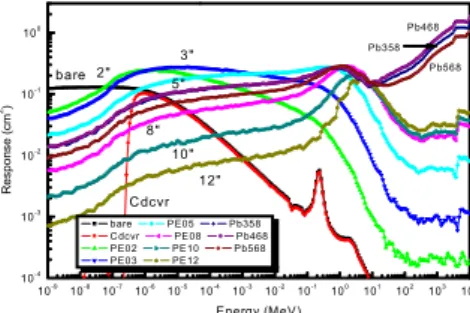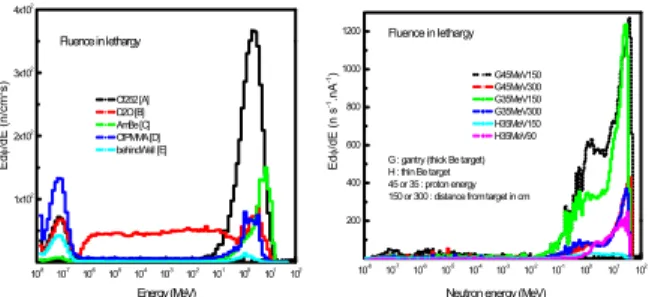Neutron Field Spectrometry Using an Extended Bonner Sphere
Bong-Hwan Kim, Jong-Soo Kim and Si-Young Chang
Korea Atomic Energy Research Institute, P.O. Box 105, Yuseong, Daejeon, Korea, bhkim2@kaeri.re.kr
1. Introduction
Neutron field spectrometry using multi spheres such as Bonner Spheres (BS) has been almost essential in radiation protection dosimetry of neutron for a long time [1] although the BS system has poor energy resolution and needs to measure several times according to the number of spheres implemented at each workplace to be monitored. Neutron spectrometry in radiation protection is not asking the fine energy resolution but requiring the easiness to operate and the neutron fluence measure- ment performance over a wide energy range.
Of many types of neutron spectrometers not using the Time-Of-Flight method, BS is a unique system available to measure neutron fluence of the almost all energy range interested and encountered in neutron fields. It enables BS to be widely used in radiation protection applications especially for the measurement of neutron fluence at the facilities such as nuclear power plants, neutron source assemblies, particle accelerator facilities, and high altitude flying aircrafts.
Korea Atomic Energy Research Institute (KAERI) manufactured an extended BS modifying the conventional BS to enhance its sensitivity for high energy neutron of about 1 GeV. This paper describes the characteristics of new KAERI BS and shows several neutron fluence spectra using it.
2. Methods and Results
2.1 Construction of KAERI BS
KAERI's BS spectrometers consists of six poly-ethylene (PE) spheres with diameters ranging from 2 inch to 12 inch and thermal sensors of which are a
6LiI(Eu) scintillator is located in the center of the sphere.
Eight detectors are used to measure the energy spectra including bare and Cd-covered detectors. The BS was modified inserting a lead inlet inside a PE sphere to make the neutron multiplication possible [2-4] in each sphere. Three kinds of new BS consisting of BS358, BS468 and BS568 were manufactured. The first and second number of each BS, i.e. 35 of BS358 stands for the inner (3) and outer (5) diameter of lead shell inside a PE sphere. A high sensitivity and the limitation of weight below 18 kg as a portable instrument were the major requirements for the new BS sets.
The response function s of an extended BS including the present BS (with diameters of 2", 3", 5", 8", 10" and 12") and two detectors which were bare and Cd-covered were calculated using the MCNPX Monte
Carlo code [5] (Ver. 2.1.5) in the energy range of 1 meV to 10 GeV. This code uses a new neutron cross section library, the LA150 which enables us to calculate the response of the BS up to 150 MeV especially for the necessary isotopes (H, C, N, O, Al, Cr, Fe, Ni, Cu and Pb) and handles the intermediate interaction physics above 150 MeV. Fig. 1 shows the calculated response
of an extended BS of a 6LiI(Eu) scintillator.
10-9 10-8 10-7 10-6 10-5 10-4 10-3 10-2 10-1 100 101 102 103 104 10-4 10-3 10-2 10-1 100 Pb358 12" 10" 8" 5" Cdcvr 3" 2" R e sp on se ( cm 2) Energy (MeV) bare PE05 Pb358 Cdcvr PE08 Pb468 PE02 PE10 Pb568 PE03 PE12 Pb468 Pb568 bare
Fig.1 Calculated response of the KAERI's extended BS (an active BS with the LiI(Eu) scintillator).
2.2 Unfolding and calibration of an extended BS
To find a real neutron spectrum, the net event due to the reaction of (n,α) or (n,p) was input into the unfolding program, MXD_FC31 [6], which adopted the maximum entropy method for the deconvolution of the multi-sphere neutron spectrometer data and was originally from the unfolding code MAXED developed by the Environmental Measurements Laboratory (EML), U.S.A. The response matrix of the original BS was replaced with that of the KAERI BS calculated in this study. The calibration of the BS was performed in the neutron irradiation room at KAERI using the
unmoderated 252Cf source which had been calibrated by
a traceable source at the National Institute of Standards and Technology, U.S.A. This calibration technique for an active BS was the same as that done by Liu et al. [7] Calibration results were consistent with the reference
252Cf [8]as shown in Table 1.
Table 1. Comparison of the reference spectrum and the unfolded spectrum of the 252Cf source measured by the
KAERI extended BS.
Flux (n.cm-2s-1) E
ave(MeV)
Reference-ISO [8] 896 2.13
Measured (BS) 897 2.13
2.3 Measurement of neutron spectra
Transactions of the Korean Nuclear Society Autumn Meeting Busan, Korea, October 27-28, 2005
The measurements at the Simulated Neutron Calibration Fields (SNCF) of KAERI were done stably without any problems in an extended BS system and the statistical uncertainty was controlled below 1.0 % except for one of SNCFs, [E] where the reference position was behind the wall and the distance from source was about 4 m. The live time for each BS measurement at [E] was 10 minutes and the statistical uncertainty was in the maximum of 2.4 %.
BS with a LiI scintillator was used to measure neutron spectra produced at the neutron therapy room of the Korea Institute of Radiological and Medical Sciences (KIRAMS) because the proton accelerator, the model of MC50, was be able to operate in the low current mode of a few nano amperes. The current level was set to 3 nA and 12 nA for 150 cm and 300 cm from the thick target installed in gantry of the neutron therapy unit. Even if a LiI(Eu) scintillator is sensitive to photon, the dead time at time of measurement appeared to be smaller than 0.6 % mostly because the portion of bremstrahlung radiation is very low. According to the calculation result using the MCNPX code the photon creation yields was only below 0.3 % even for the case 45 MeV proton striking the thick Be target.
Table 2 summarizes the dosimetric quantities of the SNCFs of KAERI and the neutron fields at KIRAMS. SNCFs is available for the routine calibration of neutron measuring instruments in KAERI and can be used as the reference scattered calibration field similar to those of simulated workplace neutron field of ISO-12789. [9]
Table 2. Dosimetric quantities of the SNCFs of KAERI and the neutron fields at the KIRAMS
10-8 10-7 10-6 10-5 10-4 10-3 10-2 10-1 100 101 102 1x102 2x102 3x102 4x102 Fluence in lethargy Ed φ /d E (n /cm 2s) Energy (MeV) Cf252 [A] D2O [B] AmBe [C] CfPMMA [D] behindWall [E] 10 -8 10-7 10-6 10-5 10-4 10-3 10-2 10-1 100 101 102 200 400 600 800 1000 1200
G : gantry (thick Be target) H : thin Be target 45 or 35 : proton energy 150 or 300 : distance from target in cm
Fluence in lethargy Ed φ /dE ( n s -1.n A -1)
Neutron energy (MeV)
G45MeV150 G45MeV300 G35MeV150 G35MeV300 H35MeV150 H35MeV90
Fig. 2. Unfolded spectra of SNCFs of KAERI and at the neutron therapy room of KIRAMS.
3. Conclusion
The new BS of KAERI can be used for neutron spectra measurement at the field of high energy neutron like as around the high energy particle accelerator or environmental neutron field due to the cosmic ray as well as at the nuclear power plant because the detection efficiency for high energy neutron is increased and the
possible energy range to measure is extended.
A series of meaningful neutron spectra consisting of the SNCFs of KAERI and the fields at the facilities of proton accelerators were collected in this work and it would be a step for constructing a catalogue of the representative neutron fields of both a workplace monitoring and the reference dosimetry for radiation protection in Korea.
REFERENCES
[1] R.L. Bramlett et al., A New Type of Neutron Spectrometer, Nucl. Inst. Meth., (9), 1-12 (1960)
[2] B. Wiegel and A.V. Alevra, NEMUS-the PTB Neutron Multisphere Spectrometer: Bonner Spheres and More, Nucl. Inst. Meth., A476, 36-41 (2002)
[3] V. Vylet, Response Matrix of an Extended Bonner Sphere System, Nucl. Inst. Meth., A476, 26-30 (2002)
[4] H.H. Hsu, K.R. Alevra and D.G. Vasilik, A New Bonner-Sphere Set for High Energy Neutron Measurement: Monte Carlo Simulation, IEEE Trans. Nucl. Sci. (41) N4, 938-940 (1994)
[5] L.S. Waters Ed., MCNPXTM User's Manual, Version 2.1.5,
(RSIC-CCC-705), TPO-E83-G-UG-X-00001, Rev.0 Nov.14 (1999)
[6] M. Reginato and P. Goldhagen, MAXED, A Computer Code For The Deconvolution of Multisphere Neutron Spectrometer Data Using the Maximum Entropy Method, US DOE Report, EML595, NY, USA (1998)
[7] J.C. Liu et al., Neutron Spectral Measurements at ORNL, Radiat. Prot. Dosim. Vol. 23, 169-178 (1990)
[8] International Organization for Standardization (ISO): Neutron Reference Radiations for Calibrating Neutron Measuring Devices used for Radiation Protection Purposes and for Determining their Response As a Function of Neutron Energy, International Standard ISO-8529 (1989)
[9] International Organization for Standardization (ISO): Reference neutron radiations : Characteristics and methods of production if simulated workplace neutron fields, Interna- tional Standard ISO-12789 (2000)
[10] International Commission on Radiation Units and Measurements (ICRU) : Conversion Coefficients for use in Radiological Protection Against External Radiation, ICRU Report 57 (1998)
Eave. : Fluence mean energy
DE rate : Dose Equivalent rate was determined using the fluence to dose equivalent conversion factor recommended by ICRU-57 [10] (on date of Feb. 26, 2004.)
[A ] 100 1.84 308 1.22 [B] 100 0.55 123 0.22 [C] 100 0.49 91 0.3 [D] 50 4.23 366 0.37 [E] 385 0.25 79 0.03 150 11.2 401 5.66 300 15.1 403 1.25 150 10.6 417 4.14 300 11 405 1.07 90 12.3 447 0.95 175 4.26 326 0.21 Pa rticle (Ta rget) Proton (Be) H*(10) (pSv.cm2) Eave. (MeV) Thickness (mm) 35 10.5 DE rate (mSv.h-1 ) Distance (cm) Ea ve. (MeV) H*(10) (pSv.cm2) DE rate (mSv.h-1. nA-1 ) Distance (cm) Ea ve. (MeV) 35 1 D2O mod. 252Cf A mBe
252Cf (behind the wall)
45 10.5
SNCF Cla ssification
252
Cf

